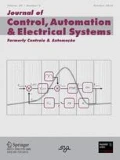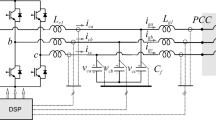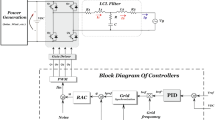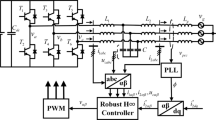Abstract
This paper deals with the problem of robust stability analysis of grid-connected converters with LCL filters controlled through a digital signal processor and subject to uncertain grid inductance. To model the uncertain continuous-time plant and the digital control gain, a discretization procedure, described in terms of a Taylor series expansion, is employed to determine an accurate discrete-time model. Then, a linear matrix inequality-based condition is proposed to assess the robust stability of the polynomial discrete-time augmented system that includes the filter state variables, the states of resonant controllers and the delay from the digital control implementation. By means of a parameter-dependent Lyapunov function, the proposed strategy has as main advantage to provide theoretical certification of stability of the uncertain continuous-time closed-loop system, circumventing the main disadvantages of previous approaches that employ approximate discretized models, neglecting the errors. Numerical simulations illustrate the benefits of the discretization technique and experimental results validate the proposed approach.





Similar content being viewed by others
Notes
See Appendix “State-Space Description of Resonant Controllers” for a more detailed description of the resonant controller matrices R and M.
The symbol \(\star \) represents a symmetric block in the LMI.
References
Althoff, M., Stursberg, O., & Buss, M. (2007). Reachability analysis of linear systems with uncertain parameters and inputs. InProceedings of the 46th IEEE conference on decision and control, New Orleans, LA (pp. 726–732).
Ackermann, J. (1993). Robust control: Systems with uncertain physical parameters. London: Springer.
Agorreta, J., Borrega, M., López, J., & Marroyo, L. (2011). Modeling and control of N-paralleled grid-connected inverters with LCL filter coupled due to grid impedance in PV plants. IEEE Transactions on Power Electronics, 26(3), 770–785.
Åström, K. J., & Wittenmark, B. (1984). Computer controlled systems: Theory and design. Englewood Cliffs, NJ: Prentice Hall Inc.
Boyd, S., El Ghaoui, L., Feron, E., & Balakrishnan, V. (1994). Linear matrix inequalities in system and control theory. Philadelphia, PA: SIAM Studies in Applied Mathematics.
Braga, M. F., Morais, C. F., Tognetti, E. S., Oliveira, R. C. L. F., & Peres, P. L. D. (2013). A new procedure for discretization and state feedback control of uncertain linear systems. In Proceedings of the 52nd IEEE conference on decision and control, Florence, Italy (pp. 6397–6402).
Braga, M. F., Morais, C. F., Tognetti, E. S., Oliveira, R. C. L. F., & Peres, P. L. D. (2014). Discretization and control of polytopic systems with uncertain sampling rates and network-induced delays. International Journal of Control, 87(11), 2398–2411.
Chen, J., Yang, F., & Han, Q. L. (2014). Model-free predictive \({H}_{\infty }\) control for grid-connected solar power generation systems. IEEE Transactions on Control Systems Technology, 22(5), 2039–2047.
Dannehl, J., Fuchs, F., Hansen, S., & Thøgersen, P. (2010). Investigation of active damping approaches for PI-based current control of grid-connected pulse width modulation converters with LCL filters. IEEE Transactions on Industry Applications, 46(4), 1509–1517.
Dannehl, J., Wessels, C., & Fuchs, F. (2009). Limitations of voltage-oriented PI current control of grid-connected PWM rectifiers with filters. IEEE Transactions on Industrial Electronics, 56(2), 380–388.
Dhar, S., & Dash, P. K. (2015). A finite time fast terminal sliding mode I-V control of grid-connected PV array. Journal of Control, Automation and Electrical Systems, 26(3), 314–335.
Francis, B. A., & Wonham, W. M. (1976). The internal model principle of control theory. Automatica, 12(5), 457–465.
Gabe, I., Montagner, V. F., & Pinheiro, H. (2009). Design and implementation of a robust current controller for VSI connected to the grid through an LCL filter. IEEE Transactions on Power Electronics, 24(6), 1444–1452.
Guerrero, J., Blaabjerg, F., Zhelev, T., Hemmes, K., Monmasson, E., Jemei, S., et al. (2010). Distributed generation: Toward a new energy paradigm. IEEE Industrial Electronics Magazine, 4(1), 52–64.
Hara, S., Yamamoto, Y., & Fujioka, H. (1996). Modern and classical analysis/synthesis methods in sampled-data control – A brief overview with numerical examples. In Proceedings of the 35th IEEE conference on decision and control, Kobe, Japan (pp. 1251–1256).
Jungers, M., Oliveira, R. C. L. F., & Peres, P. L. D. (2011). MPC for LPV systems with bounded parameter variations. International Journal of Control, 84, 24–36.
Katayama, H., & Aoki, H. (2014). Straight-line trajectory tracking control for sampled-data underactuated ships. IEEE Transactions on Control Systems Technology, 22(4), 1638–1645.
Kawamura, A., Chuarayapratip, R., & Haneyoshi, T. (1988). Deadbeat control of PWM inverter with modified pulse patterns for uninterruptible power supply. IEEE Transactions on Industrial Electronics, 35(2), 295–300.
Kothare, M. V., Balakrishnan, V., & Morari, M. (1996). Robust constrained model predictive control using linear matrix inequalities. Automatica, 32(10), 1361–1379.
Lee, S., & Won, S. (2006). Model Predictive Control for linear parameter varying systems using a new parameter dependent terminal weighting matrix. IEICE Transactions on Fundamentals of Electronics, Communications and Computer Sciences, E, 89A(8), 2166–2172.
Liserre, M., Teodorescu, R., & Blaabjerg, F. (2006). Stability of photovoltaic and wind turbine grid-connected inverters for a large set of grid impedance values. IEEE Transactions on Power Electronics, 21(1), 263–272.
Löfberg, J. (2004). YALMIP: A toolbox for modeling and optimization in MATLAB. In Proceedings of the 2004 IEEE international symposium on computer aided control systems design, Taipei, Taiwan (pp. 284–289).
Maccari, L., Massing, J. R., Schuch, L., Rech, C., Pinheiro, H., & Montagner, V. F., et al. (2012). Robust \({\cal H\it }_\infty \) control for grid connected PWM inverters with LCL filters. InProceedings of the 10th IEEE / IAS international conference on industry applications (INDUSCON) (pp. 1–6). CE, Brazil: Fortaleza.
Maccari, L., Massing, J. R., Schuch, L., Rech, C., Pinheiro, H., Oliveira, R. C. L. F., et al. (2014). LMI-based control for grid-connected converters with LCL filters under uncertain parameters. IEEE Transactions on Power Electronics, 29(7), 3776–3785.
Mattavelli, P., Spiazzi, G., & Tenti, P. (2005). Predictive digital control of power factor preregulators with input voltage estimation using disturbance observers. IEEE Transactions on Power Electronics, 20(1), 140–147.
Meza, C., Biel, D., Jeltsema, D., & Scherpen, J. (2012). Lyapunov-based control scheme for single-phase grid-connected PV central inverters. IEEE Transactions on Control Systems Technology, 20(2), 520–529.
Moraes, V. M., Castelan, E. B., & Moreno, U. F. (2013). Full-order dynamic output-feedback compensator for time-stamped networked control systems. Journal of Control, Automation and Electrical Systems, 24(1), 22–32.
Mukherjee, N., & De, D. (2013). Analysis and improvement of performance in LCL filter-based PWM rectifier/inverter application using hybrid damping approach. IET Power Electronics, 6(2), 309–325.
Olalla, C., Queinnec, I., Leyva, R., & Aroudi, A. E. (2011). Robust optimal control of bilinear DC-DC converters. Control Engineering Practice, 19(7), 688–699.
Oliveira, R. C. L. F., & Peres, P. L. D. (2007). Parameter-dependent LMIs in robust analysis: Characterization of homogeneous polynomially parameter-dependent solutions via LMI relaxations. IEEE Transactions on Automatic Control, 52(7), 1334–1340.
Oppenheimer, E. P., & Michel, A. N. (1988). Application of interval analysis techniques to linear systems: Part ii-The interval matrix exponential function. IEEE Transactions on Circuits and Systems, 35(10), 1230–1242.
Parker, S., McGrath, B., & Holmes, D. (2014). Regions of active damping control for LCL filters. IEEE Transactions on Industry Applications, 50(1), 424–432.
Pena-Alzola, R., Liserre, M., Blaabjerg, F., Sebastian, R., Dannehl, J., & Fuchs, F. (2014). Systematic design of the lead-lag network method for active damping in LCL-filter based three phase converters. IEEE Transaction on Industrial Informatics, 10(1), 43–52.
Sturm, J. F. (1999). Using SeDuMi 1.02, a MATLAB toolbox for optimization over symmetric cones. Optimization Methods and Software, 11(1–4), 625–653. http://sedumi.ie.lehigh.edu/.
Su, H., Wang, J., & Chu, J. (1998). Robust memoryless \({{\cal H\it }}_\infty \) control for uncertain linear time-delay systems. In Proceedings of the 1998 American control conference, Philadelphia, PA, USA (pp. 3730–3731).
Wada, N., Saito, K., & Saeki, M. (2006). Model predictive control for linear parameter varying systems using parameter dependent Lyapunov function. IEEE Transactions on Circuits and Systems II: Express Briefs, 53(12), 1446–1450.
Yin, J., Duan, S., & Liu, B. (2013). Stability analysis of grid-connected inverter with LCL filter adopting a digital single-loop controller with inherent damping characteristic. IEEE Transaction on Industrial Informatics, 9(2), 1104–1112.
Acknowledgements
The work was supported by Brazilian agencies CAPES, CNPq (Grants 307536/2012-2, 477487/2013-0), and FAPESP (Grants 2011/08312-6, 2014/22881-1).
Author information
Authors and Affiliations
Corresponding author
Appendices
State-Space Description of Resonant Controllers
In order to ensure zero steady-state error and also to reject harmonic disturbances, resonant controllers can be used. In continuous-time, it is possible to consider the following resonant controller
where
and the tracking error is given by
In this representation, \(\omega _i\) is the frequency of resonant controller and \(\zeta _i\) is a damping factor, employed to avoid problems in the discrete-time implementation related with placing controller poles at the border of the unit circle.
A state-space discrete-time representation of this controller is given by
where \( \xi _i(k) \in \mathbb {R}^{2 \times 1}\), \( R_i \in \mathbb {R}^{2 \times 2}\), \(M_i \in \mathbb {R}^{2 \times 1}\).
Note that (21) also describes a resonant controller, but specialized for state feedback.
In the general case, a set of the above controllers can be used to represent multiple resonant controllers as
where
In this representation, the state vector has dimension 2n, where n is the number of resonant controllers to be implemented, and each resonant controller is discretized independently, resulting in the matrices R (block diagonal matrix) and M.
System Parameters and Control Gains
The parameters of the system used for controller design and to obtain the experimental results are given in Table 2.
Considering the parameters of Table 2 and tunning the resonant controllers at the frequencies of 60, 180, 300 and 420 Hz, the control gains designed in Maccari et al. (2014), used in Sect. 6, are given by (truncated with 4 decimal digits)
Multi-nomial Series Development
In the matrix case, products in multi-nomial series are non-commutative. In this case, one can write \(A_{c}(\alpha )\) as
where, \( A_{c_{p}} = A_{c_{p_1}} \cdots A_{c_{p_q}}\) \(\alpha ^k=\alpha _1^{k_1} \alpha _2^{k_2} \cdots \alpha _N^{k_N}\), \(k=(k_1 k_2 \cdots k_N)\), \(\alpha _p=(\alpha _{p_1}, \alpha _{p_2}, \ldots , \alpha _{p_q}\)), \(p=(p_1 p_2 \cdots p_q)\),
\( {\mathcal {P}}(q) \) is the set of q-tuples obtained as all possible combinations of nonnegative integers \( p_i \), \( i = 1, \ldots , q \), such that \( p_i \in \{ 1,\ldots ,N \} \), that is,
and \( {\mathcal {R}}(k) \), \(k\in {\mathcal {K}}(q)\), is the subset of all q-tuples \(p \in {\mathcal {P}}(q)\) such that the elements j of p have multiplicity \(k_j\), for \(j=1,\ldots ,N\), that is,
where \(m_p(j)\) denotes the multiplicity of the element j in p.
By definition, for N-tuples k and \(k'\), one has that \(k \ge k'\) if \(k_{i} \ge k'_{i}\), \(i = 1, \ldots , N\). Operations of summation \(k + k'\) and subtraction \(k - k'\) (whenever \(k' \le k\)) are defined componentwise.
Proof of Theorem 1
To prove Theorem 1, apply Schur’s complement in (18) to get
Knowing that \(\varDelta A_{cl}^{\ell }(\alpha )' \varDelta A_{cl}^{\ell }(\alpha ) < \delta _{{\tilde{A}}}^{2}I\) and using Lemma 1, one obtains
which is equivalent to
where \({A_{cl}}(\alpha )\) is given by (16). Finally, multiplying (27) by \({\mathcal {B}}' = \begin{bmatrix} -I&{A_{cl}}(\alpha )'\end{bmatrix}\) on the left and by \({\mathcal {B}}\) on the right, one gets \(W(\alpha ) - (A_{cl}^{\ell }(\alpha ) + \varDelta A_{cl}^{\ell }(\alpha ))' W(\alpha ) (A_{cl}^{\ell }(\alpha ) + \varDelta A_{cl}^{\ell }(\alpha )) > 0,\) that ensures the stability of the closed-loop system (15).
Rights and permissions
About this article
Cite this article
Braga, M.F., Morais, C.F., Maccari, L.A. et al. Robust Stability Analysis of Grid-Connected Converters Based on Parameter-Dependent Lyapunov Functions. J Control Autom Electr Syst 28, 159–170 (2017). https://doi.org/10.1007/s40313-017-0301-7
Received:
Revised:
Accepted:
Published:
Issue Date:
DOI: https://doi.org/10.1007/s40313-017-0301-7




